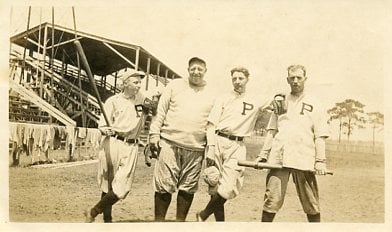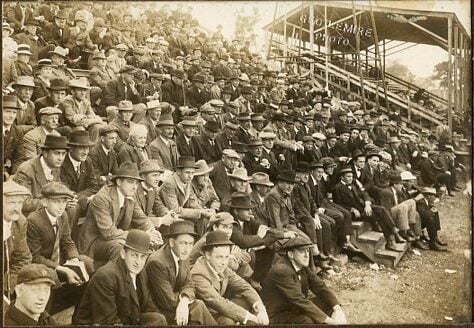By 1914, St. Pete’s population had grown to over 7,000, from only 1,600 people in 1900. Numerous new homes, businesses, and public works also changed the shape and feel of the city. New roads, rails, and trolleys made getting around a lot easier. and for a few short months in 1914, brave souls could even arrive via air on the St. Petersburg- Tampa Airboat Line. St. Pete leaders, contrary to those in other growing cities of the era, chose not to rely on industrial development; instead, they staked the town’s future on tourism. “America’s favorite pastime” was seen as a potentially powerful magnet to attract winter visitors to the Sunshine City.
“The Sunshine City has the inside track”
Led by Al Lang, boosters found a team looking for a change: the last-place St. Louis Browns. St. Pete’s weather and local connections were rumored to have put it on “the inside track.” As a further enticement, the newly formed St. Petersburg Baseball & Amusement Co. promised the team free room and board and a new training facility and baseball stadium. This sealed the deal. Soon after, Sunshine Park began to emerge from the overgrown lot adjacent to Coffee Pot Bayou. Workers cleared the Florida pines, planted grass, and packed fine-grade clay imported from Jacksonville around the bases in order to “protect base runners from scratches and bruises when rolling and sliding on the ground.” Supervised by Browns manager and future Hallof- Famer Branch Rickey, workers soon installed batting cages, sliding pits, and sprinting lanes. Rickey was pleased with the results, declaring the facility “one of the best I’ve ever seen for training purposes.” Fans were in for a treat. Sunshine Park offered spectators a choice of elevated box seats, a covered grandstand, or open bleachers. Numerous refreshment and souvenir stands provided game-day needs except for a cold beer, as Pinellas County was “dry” at the time. Excitement was high as opening day approached. After months of work, Sunshine Park was ready for the February 27, 1914, home opener, and the Times predicted “a record crowd.”

“Everybody went to the game”
Opening day proved them right. Schools were let out for the day, and businesses shut their doors at noon. Fans came by special trains, extra trolley cars, the occasional automobile, and on foot. Clearly, everyone wanted to witness baseball history being made. Sunshine Park (or Coffee Pot Bayou Ball Field, as the locals preferred to call it) was filled to capacity with more than 4,000 attendees. Bleacher seats were only 25 cents, but spectators seeking a free view also perched in nearby pine trees. A woman was even seen atop the roof of a house behind center field. Simply put, “Everybody went to the game.” Not content with that summary, the Times provided an exhaustive list to prove their case: “railroad magnates, famous authors, footlight favorites, gentlemen of the cloth, ‘sporty’ men, doctors, lawyers, judges, teachers, merchants, clerks, hash hustlers, cab drivers, chauffeurs, Negro laborers … fashionably gowned women and faultlessly dressed men; women in plain business clothes and men who didn’t give ‘a hang’ how they looked … [as well as] a score or more of kids who would rather see the game hanging onto the top rail of the fence.” The Browns lost to the Cubs, but that barely dampened the excitement. The Times reported that the fervor “made the pine woods and the shores of the tranquil bayou reverberate with the welcome to the national game.” Major League Baseball had arrived in the Sunshine City!

“Equal to any professional diamond”
Despite the stellar training conditions, the Browns went on to an abysmal losing season and decided not to return in 1915. Fortunately, Al Lang had been hard at work recruiting another team. In October 1914, the also-terrible Philadelphia Nationals announced they would hold spring training in St. Pete for the 1915 season. Once again, excitement was high. As happened the previous year, a holiday was declared for the opening-day game against the Cubs. The Times reminded locals and tourists that “Coffee Pot park is equal to any professional diamond in the South,” and at a fraction of the cost of others. Despite the hype, the crowds weren’t quite as large as those for opening day 1914. Including a “lively delegation [of Cubs fans] from Tampa,” 2,500 people watched the Cubs defeat the Phillies. Despite this early loss, however, the Phillies secured the National League pennant that year before closing the season with a World Series loss. Seeking to capitalize on the magic of that stellar season, they returned to St. Pete in 1916 and found a welcoming crowd, as proved by the 2,000 fans waiting at the train station. They also returned in 1917 and 1918. The Great War had begun to dramatically affect baseball’s attendance and scheduling. That shift contributed to the Phillies’ decision to not renew their contract for the upcoming year. Workers began demolition on the mostly abandoned “Old Coffee Pot Ball Yard” in March 1919. Only five years after its opening day, Sunshine Park’s short but history-making era ended. When Major League ball returned in 1921, it found a new home.
Resources available on request.


